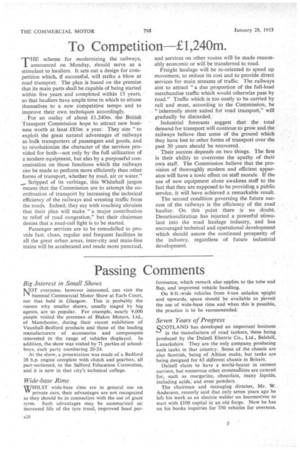To Competition £1,240m.
Page 22

If you've noticed an error in this article please click here to report it so we can fix it.
THE scheme for modernizing the railways, announced on Monday, should serve as a stimulant to hauliers. It sets out a design for competition which, if successful, will strike a blow at road transport. The plan is based on the premise that its main parts shall be capable of being started within five years and completed within 15 years, so that hauliers have ample time in which to attune themselves to a new competitive tempo and to improve their own techniques accordingly.
. For an outlay of about £1,240m. the British Transport Commission hope to attract new business worth at least £85m. a year. They aim "to exploit the great natural • advantages of railways as bulk transporters of passengers and goods, and to revolutionize the character of the services provided for both—not only by the full utilization of a modern equipment, but also by a purposeful concentration on those functions which the railways can be made to perform more efficiently than other forms of transport, whether by road, air or water."
Stripped of its verbiage, this Whitehall jargon means that the Commission are to attempt the coordination of transport by increasing the technical efficiency of the railways and wresting traffic from the roads. Indeed; they say with touching altruism that their plan will make "a, major contribution to relief of road congestion," but their chairman denies that a road-rail fight is to be started.
Passenger services are to be remodelled to provide fast, clean, regular and frequent facilities in all the great urban areas, inter-city and main-line trains will be accelerated and made more punctual, and services on other routes will be made reasonably economic or will be transferred to road.
Freight haulage will be re-oriented to speed up movement, to reduce its cost and to provide direct services for main streams of traffic. The railways aim to attract "a due proportion of the full-load merchandise traffic which would otherwise pass by road." Traffic which is too costly to be carried by rail and must, according to the Commission, be "inherently more suited for road transport," will gradually be discarded.
Industrial forecasts suggest that the total demand for transport will continue to grow and the railways believe that some of the ground which they have lost to other forms of transport over the past 30 years should be recovered.
Their success depends on two things. The first is their ability to overcome the apathy of their own staff. The Commission believe that the provision of thoroughly modern and efficient apparatus will have a tonic effect on staff morale. If the use of new equipment alone awakens staff to the fact that they are supposed to be providing a public service, it will have achieved a remarkable result.
The second condition governing the future success of the railways is the efficiency of the road haulier. On this point there is no doubt. Denationalization has injected a powerful stimulant into the road haulage industry, and has encouraged technical and operational development which should assure the continued prosperity of the industry, regardless of future industrial development.




















































































